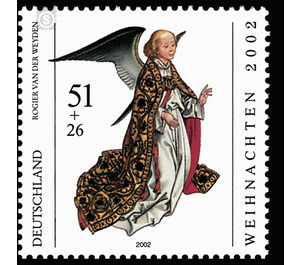Christmas - Germany / Federal Republic of Germany 2002 - 51 Euro Cent
Theme: Mythology
| Country | Germany / Federal Republic of Germany |
| Issue Date | 2002 |
| Face Value | 51.00 |
| Perforation | K 13 3/4 |
| Stamp Type | Postage stamp |
| Item Type | Stamp |
| Chronological Issue Number | 2158 |
| Chronological Chapter | GER-BRD |
| SID | 400858 |
| In 24 Wishlists | |
The special stamps of the series »Christmas« appear with supplements for the Federal Association of the Free Welfare. For more than 50 years, welfare charitable proceeds have been donated to charities that help wherever aid is not enough. This year's Christmas stamps are based on excerpts from the works "The Annunciation to Mary" and "The Marian Altar" by the Flemish painter Rogier van der Weyden. Van der Weyden is one of the most important artists of Old Dutch painting. His realistic depictions have influenced 15th century art development far beyond the Netherlands. Born in 1399 or 1400 in the French-speaking city of Tournai, he was first called Rogelet de la Pasture. He was apprenticed to the painter Robert Campin (around 1375-1444) and in 1432 earned the title of master. His stay in Brussels is documented since 1435. Here his name was translated literally into "van der Weyden". In Brussels, he worked as a city painter. For the town hall of the city he created four large pictures, which were destroyed 1695 in a fire. Among his clients were in addition to the city council of the Duke Philip the Good of Burgundy and the Florentine banking family Medici. Rogier van der Weyden died in 1464 in Brussels. None of his paintings is signed or covered by contemporary testimonies. Only later sources could open his extensive work. The postage stamp "The Annunciation to Mary" shows a section of his eponymous work, which may have originated around 1435 in Paris. You can see the archangel Gabriel. He is dressed like a cleric performing a solemn act at the altar. The angel brings the good news of the Incarnation of Christ to Mary. The special stamp "Marienaltar" shows the Holy Family. The detail is from the "Miraflores Altar" donated by King Juan II of Castile in 1445 to the Carthusian Monastery of Miraflores near Burgos in northern Spain. Mary sits on the floor and humbly prays the child lying on her lap. On the right is Joseph, whose face expresses sympathy and concern.


